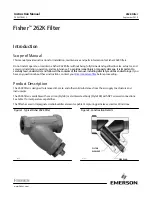
Maintenance
22
Maintenance
Magnetic systems attract Ferromagnetic particles. Regular cleaning is essential.
A clean magnet functions considerably better
All parts are best cleaned with pressurized air and/or a soft cloth. It’s also possible to deep clean with
special cleaning fluids that do not harm the material. Ensure that these fluids do not contaminate the
product
Regularly check that all warning pictograms and the identification plate are present at the correct locations
on the device. If warning pictograms or the identification plate should get lost or damaged, immediately
apply new ones to the original locations.
Always inform operating personnel regarding planned inspections, maintenance, repairs or if attending to
breakdowns.
Because of the low rotational motor speed the motor, bearings and oil seal ring are not heavy loaded.
Normal wear can however always occur.
•
After a few years the oil seal ring in the back side (motor side) of the housing will probably need to
be replaced by a new one.
•
Depending on how abrasive the product is, the extractor tubes can show wear.
Execute all work to the device while motor and product flow is stopped. Be careful with tools: when
power is off, the magnet force is still present.
Cleaning the rotor (Fe parts disposal)
Clean the extractor on a regular basis to maintain maximum performance. An overloaded magnet will
not function sufficiently and lose the Fe particles it has already caught. These particles will subsequently
be swept away by the incoming raw product into the outlet canal. The frequency with which you need to
clean depends on the volume flow of your product and the quantity of Fe contamination per volume
entity.
Remember to STOP THE PRODUCT FLOW before opening the magnet’s door!
Cleaning & ATEX
To prevent explosion risk, avoid dust clouds and the build-up of dust layers.
If dust particles or layers heat up they may ignite and burn. This in turn can ignite airborne dust clouds
and cause an explosion.






































